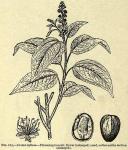 313. TIGLIUM.—CROTON SEED. The seed of Cro'ton tig'lium Linné, a small tree indigenous to China, but extensively cultivated in India. The fruit is a smooth capsule about the size of a large hazelnut, 3-celled, each containing a single seed. The seeds are from 12 to 15 mm. (½ to ⅗ in.) long, oval-oblong, resembling castor-oil seeds in shape but somewhat larger, and quadrangular, and with the caruncle usually absent; the testa is soft, dull yellowish-brown, generally partially, but occasionally wholly, rubbed off from the black tegmen by friction, giving the seeds a mottled or nearly black appearance; albumen and embryo yellowish-brown; odor feeble; taste acrid. It yields about 50 to 60 per cent. of an acrid fixed oil.
313. TIGLIUM.—CROTON SEED. The seed of Cro'ton tig'lium Linné, a small tree indigenous to China, but extensively cultivated in India. The fruit is a smooth capsule about the size of a large hazelnut, 3-celled, each containing a single seed. The seeds are from 12 to 15 mm. (½ to ⅗ in.) long, oval-oblong, resembling castor-oil seeds in shape but somewhat larger, and quadrangular, and with the caruncle usually absent; the testa is soft, dull yellowish-brown, generally partially, but occasionally wholly, rubbed off from the black tegmen by friction, giving the seeds a mottled or nearly black appearance; albumen and embryo yellowish-brown; odor feeble; taste acrid. It yields about 50 to 60 per cent. of an acrid fixed oil.
313a. OLEUM TIGLII.—CROTON OIL. A rather viscid, pale yellowish to brown fixed oil, with a peculiar, faint odor, and an exceedingly hot, acrid taste, continuing in the mouth for several hours. It consists of the glycerides of lauric, myristic, palmitic, stearic, formic, acetic, crotinic, C4H6O2, isobutyric, isovalerianic, and tiglinic, C5H8O2, acids. Saponification value 200 to 215, iodine value 104 to 110. The vesicating properties are due to a croton resin. Purgative principle is insoluble in alcohol. Drastic purgative, capable of causing death in excessive doses. Dose: ½ to 2 drops (0.0324 to 0.13 mil), in emulsion. Applied externally in liniment, it is a powerful rubefacient.

